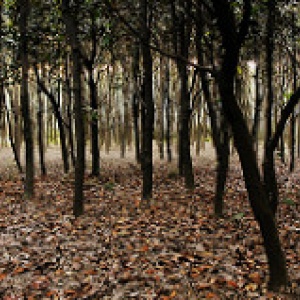
Initiated in 1999, the Grain-for-Green Program was set up primarily to reduce soil erosion and uses cash payments to incentivise people to replant trees on sloped crop and scrubland. This study examines the effects on bird and bee species in the scheme across the country. It finds that the program has not greatly benefited birds and bees due to the common practice of monoculture tree planting.
Initiated in 1999, the Grain-for-Green Program was set up primarily to reduce soil erosion and uses cash payments to incentivise people to replant trees on sloped crop and scrubland. This study examines the effects on bird and bee species in the scheme across the country. It finds that the program has not greatly benefited birds and bees due to the common practice of monoculture tree planting.
The authors conducted a study which 1) examined the peer-reviewed literature to gather information on the tree composition of Grain-for-Green forests across China, 2) compares bird and bee species richness in forests planted in the program’s forests in south-central Sichuan, and 3) examines the opportunity costs associated with planting different types of forest.
The study finds that while the program had re-established 27.8 million hectares of forest by 2013, the vast majority of its forests are monocultures or very simple mixed forests. The forests are intended for the production of timber, tree fruits and other cash crops - restoration for wildlife was not one of the primary reasons for their establishment. The field study showed that in south-central Sichuan, the reforestation using monocultures typically resulted in net losses of bird diversity, even compared to cropland, while mixed forest generally resulted in net gains. All the types of Grain-for-Green reforestation resulted in clear losses of bee diversity (see figure below).

Figure | The number of habitat specialist species associated with each land-cover type. The three monoculture GFGP forests are represented as one ‘monoculture GFGP forest’ category. Bars of different colours represent different land-cover types: yellow, cropland; dark green, native forest; black, monoculture and purple, mixed GFGP forest.
The authors note that the program, because of its immense scale and wide-reach across China’s provinces, holds potential to yield co-benefits for conservation if deliberate efforts were made to achieve conservation goals. Planting native species in compositions similar to native forest would probably provide most benefits but require a major change to the scheme. Yet even within the scheme gains could be made by promoting mixed forests over monocultures.
Abstract
Reforestation is a critical means of addressing the environmental and social problems of deforestation. China’s Grain-for-Green Program (GFGP) is the world’s largest reforestation scheme. Here we provide the first nationwide assessment of the tree composition of GFGP forests and the first combined ecological and economic study aimed at understanding GFGP’s biodiversity implications. Across China, GFGP forests are overwhelmingly monocultures or compositionally simple mixed forests. Focusing on birds and bees in Sichuan Province, we find that GFGP reforestation results in modest gains (via mixed forest) and losses (via monocultures) of bird diversity, along with major losses of bee diversity. Moreover, all current modes of GFGP reforestation fall short of restoring biodiversity to levels approximating native forests. However, even within existing modes of reforestation, GFGP can achieve greater biodiversity gains by promoting mixed forests over monocultures; doing so is unlikely to entail major opportunity costs or pose unforeseen economic risks to households.
Reference
Hua, F., Wang, X., Zheng, X., Fisher, B., Wang, L., Zhu, J., Tang, Y., Douglas, W.Y. and Wilcove, D.S., 2016. Opportunities for biodiversity gains under the world/'s largest reforestation programme. Nature Communications,7.
The paper can be found here (open access)
Earlier in 2006, researchers from Michigan found that reported reforestation in China could be confirmed with satellite data: see this summary.







Post a new comment »